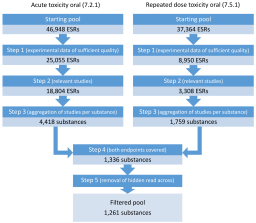Alternative acute oral toxicity assessment under REACH based on sub-acute toxicity values
Main Article Content
Abstract
The REACH Regulation requires information on acute oral toxicity for substances produced or imported in quantities greater than one ton per year. When registering, animal testing should be used as last resort. The standard acute oral toxicity test requires use of animals. Therefore, the European Chemicals Agency examined whether alternative ways exist to generate information on acute oral toxicity. The starting hypothesis was that low acute oral toxicity can be predicted from the results of low toxicity in oral sub-acute toxicity studies. Proving this hypothesis would allow avoiding acute toxicity oral testing whenever a sub-acute oral toxicity study is required or available and indicates low toxicity. ECHA conducted an analysis of the REACH database and found suitable studies on both acute oral and sub-acute oral toxicities for 1,256 substances. 415 of these substances had low toxicity in the sub-acute toxicity study (i.e., NO(A)EL at or above the limit test threshold of 1,000 mg/kg). For 98% of these substances, low acute oral toxicity was also reported (i.e., LD50 above the classification threshold of 2,000 mg/kg). On the other hand, no correlation was found between lower NO(A)ELs and LD50. According to the REACH Regulation, this approach for predicting acute oral toxicity needs to be considered as part of a weight of evidence analysis. Therefore, additional sources of information to support this approach are presented. Ahead of the last REACH registration deadline, in 2018, ECHA estimates that registrants of about 550 substances can omit the in vivo acute oral toxicity study by using this adaptation.
Article Details
Articles are distributed under the terms of the Creative Commons Attribution 4.0 International license (http://creativecommons.org/licenses/by/4.0/), which permits unrestricted use, distribution and reproduction in any medium, provided the original work is appropriately cited (CC-BY). Copyright on any article in ALTEX is retained by the author(s).


